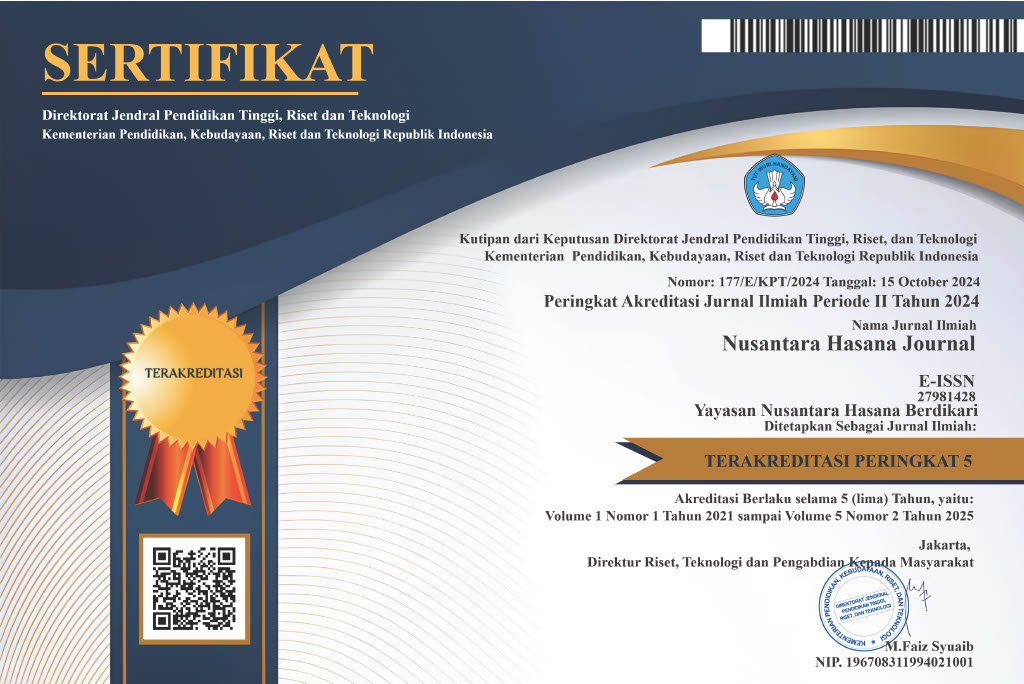EDUKASI DESAIN ERGONOMIS FASILITAS BELAJAR BERDASARKAN DATA ANTROPOMETRI DI PAUD KELURAHAN AIE PACAH
DOI:
https://doi.org/10.59003/nhj.v3i7.1034Keywords:
ergonomic desain. Anthropometry, school benchesAbstract
Early childhood, the golden age of growth and development for children, is a very critical period in the stage of human development. Since 2003, the government has issued Law No. 20 of 2003 concerning the national education system, including the PAUD education system (early childhood education). According to the Ministry of Education and Culture, in the 2020–2021 school year, 6,346,193 early childhood education students in Indonesia were members of private and public educational institutions. According to early childhood education statistics, more classrooms are lightly damaged than good. The learning process in early childhood education institutions takes place actively and involves children who are at the most active and energetic stage, so they need ergonomic learning facilities whose size is determined by the child's body size and which are comfortable and safe. The ergonomic design of this learning facility also aims to maintain bone health and early childhood posture because it is still vulnerable and easy to change. After all, it is still in its infancy. Evaluation of school benches, measurement of children's anthropometric data, and education on the importance of using ergonomic school equipment have been carried out in one of the PAUD/TK locations in the Koto Tangah sub-district. The results obtained by the school bench used are quite ergonomic when compared to the anthropometric size of students at the school.
Downloads
References
Ahmad, S., Waluyo, & Fatimah, F. (2013). Hubungan Kebiasaan Sarapan Pagi dan Jajan dengan Status Gizi Anak Sekolah Dasar di SD Negeri Kledokan Depok Sleman. Medika Respati, 8, 1-15.
Hasimjaya J, Wibowo M, Wondo D. (2017). Kajian Antropometri dan ergonomic desain mebel Pendidikan anak usia dini 3-4 ytahun dia siwanlakerto. Jurnl Intra Vol5 No.2 ( 449-459).
Eko SH, Suyasna N, Prasetyo RBP. ( 2017). Kajian aksesibilitas dan ergonomic pada mebel PAUD Al Abidin Surakarta. Diakses dari http://repository.isi-ska.ac.id/2464/1/Eko%20Sri%20Haryanto%2C%20M.Sn%202017.pdf
Kementrian Pendidikan dan kebudayaan. (2021). Statistik Pendidikan anak usia dini. Pusdatin Kemedikbud Indonesia
Kalsum U, Karnefi A, Hendriani B, Nurfath L, Pratiwi S. (2020). Redesain kursi perkuliahan mahasiswa prodi ilmu Kesehatan masyrakat uniersitas jambi. JMJ. Special Issues,JAMHESIC.69-78
Herawati L, Pawitra TA. (2013). Evvaluasi data antropometri anak-anak usia 4-6 tahun dijawa timur dan aplikasi pada perancangan fasilitas belajar disekolah.JITI, 12(2) 141-151
Siaui N, Wibowo M, Rizqi T. (2018) Analisi ergonomic terhadap desain mebel pada sekolah anak usia dini dengan antropometri anak usia 2-3 tahun. Jurnal Intra Vol6.no.2 83-93
Andrijanto, Putri HA. (2013). Pengukuran antropometri murid taman kanak-kanak sebagai acuan perancanagn kursi anak yang ergonomis studi kasus di taman kana-kanak swasta X. Integra vol2 no.2. 107-116
Susanti N Sa. Penyuluhan Fisioterapi Pada Sikap Ergonomis Untuk Mengurangi Terjadinya Gangguan Musculoskeletal Disorders (Msds) Di Komunitas Keluarga Desa Kebojongan Kec. Comal Kab. Pemalang. Abdimas. 2021;2(1):8–19.
Rusdiarti R. Analisis Pengukuran Ketepatan Antropometri Tinggi Badan Balita pada Pelatihan Kader Posyandu di Panduman Kecamatan Jelbuk. Health Information: Jurnal Penelitian. 2019;11(2):171–9.
Downloads
Published
How to Cite
Issue
Section
License
Copyright (c) 2023 Melya Susanti

This work is licensed under a Creative Commons Attribution-NonCommercial-ShareAlike 4.0 International License.
NHJ is licensed under a Creative Commons Attribution-NonCommercial-ShareAlike 4.0 International License.
Articles in this journal are Open Access articles published under the Creative Commons CC BY-NC-SA License This license permits use, distribution and reproduction in any medium for non-commercial purposes only, provided the original work and source is properly cited.
Any derivative of the original must be distributed under the same license as the original.
























